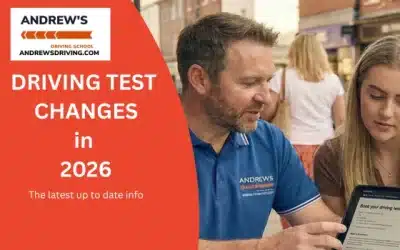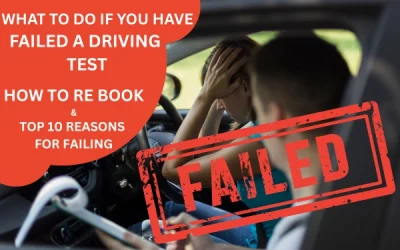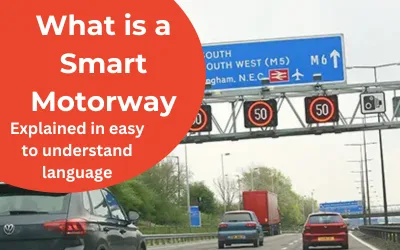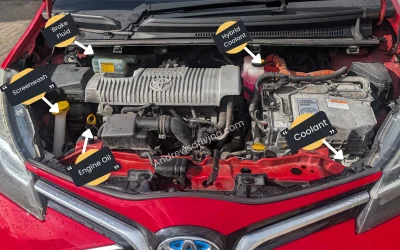How to remember stopping distances
Easy way remember stopping distances for your driving theory test
Learn your highway code stopping distances with this easy to remenber formula
Theory Test Stopping Distances
Below are the stopping distances from the Highway Code. They can be tricky to memorise, but here’s a simple formula to help make it easier.
How long does it take to stop at 30mph?
Have you ever stopped to think about the time it takes to bring your car to a complete halt when driving at 30mph? The information below reveals the duration required for a full stop, considering ideal conditions like a dry road and an attentive driver behind the wheel.

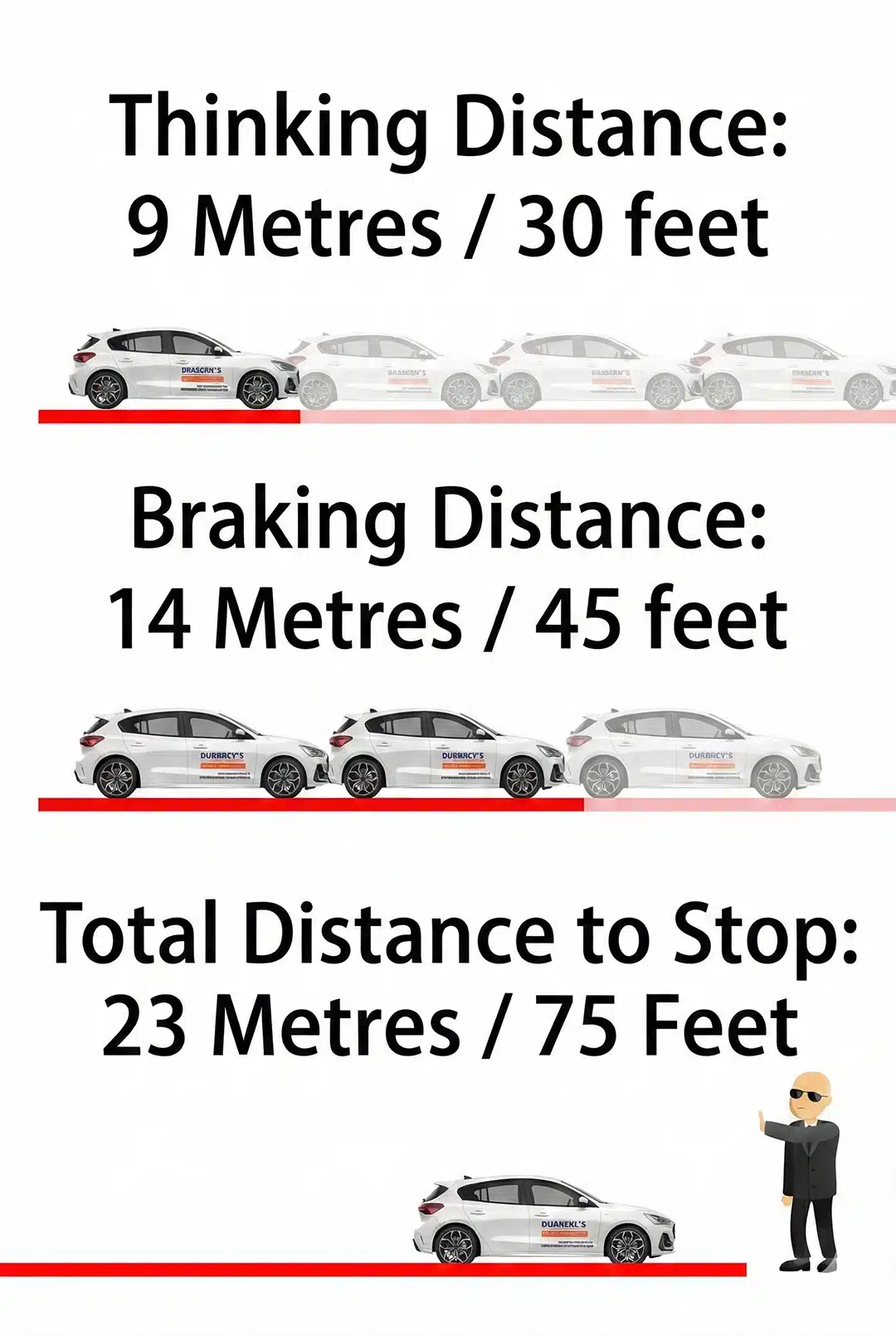
What Does Stopping Distance Mean?
Stopping distance is the total distance a vehicle travels from the moment a driver spots a hazard to when the car comes to a complete stop. It consists of two parts: thinking distance (the distance covered while the driver reacts) and braking distance (the distance it takes to stop after the brakes are applied). You can estimate the total distance in feet by multiplying your speed by a factor—starting at 2 for 20 mph and adding 0.5 for every 10 mph increase. For example, at 30 mph: 30 × 2.5 = 75 feet.
🚗 Theory Test Guide: Stopping Distances
A common theory test question asks for the overall stopping, thinking, or braking distance at 30 mph. You don’t need to memorise every number—just use this easy method.
✅ Overall Stopping Distance (Dry)
The trick is to multiply your speed by a specific number. Add 0.5 to the multiplier for every extra 10 mph.
= 40 ft
= 75 ft
= 120 ft
✅ Weather Conditions
🌧️ Wet Roads:
Double the dry stopping distance.
❄️ Ice or Snow:
Multiply by 10!
(e.g., 30 mph on ice = 600 ft / 60 car lengths)
✅ Thinking Distance
This is the easiest part. In feet, the thinking distance is always the same number as your speed.
= 20 ft
= 30 ft
= 40 ft
✅ Braking Distance
Braking distance is simply what is left after you subtract the thinking distance from the total.
📝 Example at 40 mph
Total Distance: 120 ft
(40 x 3)
– Thinking Distance: 40 ft
(Same as speed)
= Braking Distance: 80 ft
Note: This method isn’t exact for real-world driving physics, but it is perfect for passing your theory test.
Easy-to-Remember Stopping Distance Formula
| Speed (mph) | Multiplier | Stopping Distance (ft) |
|---|---|---|
| 20 | × 2 | 40 ft |
| 30 | × 2.5 | 75 ft |
| 40 | × 3 | 120 ft |
| 50 | × 3.5 | 175 ft |
| 60 | × 4 | 240 ft |
| 70 | × 4.5 | 315 ft |

Remembering stopping distances is easy.
Why Understanding Stopping Distances Matters
Knowing how stopping distances increase with speed is essential for safe driving. At 30 mph, the stopping distance is about 75 feet, but at 40 mph, it jumps by 45 feet—a rise of over 50%. At 70 mph, you may need the length of a football field to stop, even in ideal conditions. In wet weather, that distance can more than double. Thinking distance—the distance your car travels before you even react—is equal to your speed in feet. That means at 40 mph, you’ve already travelled 40 feet before braking. Always leave a 2-second gap, or 4 seconds in the wet.

The 2 Second Rule
One of the key principles for safe driving is the 2 second rule, which helps maintain safe distances on the road. In dry conditions, it is important to keep at least a 2 second gap between your vehicle and the one ahead. This gap should be increased to 4 seconds in wet weather to account for longer stopping distances. A simple way to check this distance is to watch when the car in front passes a fixed object, like a lamppost or a traffic sign, and then mentally say “only a fool breaks the 2 second rule” until you reach that object. If you arrive too soon, you are too close. In heavy rain, repeat the phrase to create a 4 second cushion. In icy conditions, aim for a much larger gap of about 20 seconds or consider leaving your car at home, since braking can be very difficult on ice. For more information on road safety, visit the Royal Society for the Prevention of Accidents at Rospa.com for helpful tips and guidance to keep you safe while driving. Remember that worn or shallow tyre tread can further increase stopping distances, especially in wet conditions—learn more about tyre tread depth here.
Advice & Tips for driving tests ( Practical & Theory)
New Driver Tips & Advice
How Will the 2026 Booking Changes Affect Your Driving Test?
Big Changes Coming to The Driving Test Booking System – What Learners Need to Know for 2026A fairer, safer way to book your test is on the horizon. Here’s how the new DVSA rules will put control back in your hands. .The Announcement: A Major Shake-Up for Learner...
When Can I Rebook My Driving Test After Failing?
When Can I Rebook My Driving Test After Failing? And the top 10 reasons for failing a driving testThe 10-Working Day Rule and Rebooking Times If you’ve just found out that you didn’t pass your practical driving test, it’s completely normal to feel disappointed — but...
What is a Smart Motorway
What Is A Smart Motorway? 🛣️ Smart Motorways: What New Drivers Need to Know🚗 Smart Motorways: The Upsides and the Oh-So-Real Risks Picture this: you’re cruising along, the overhead gantries glow with calm arrows, and the traffic moves like it’s been politely coached....
Toyota-Yaris-1.5-hybrid-engine-diagram
Toyota Yaris 1.5L Hybrid Electric EngineToyota Yaris Hybrid – Engine Bay Guide (Show Me, Tell Me) This diagram shows the main parts under the bonnet of your Yaris Hybrid. You might be asked about these in your driving test. The labels point to: Brake fluid tank –...
Suzuki Swift Booster Jet Hybrid Engine Diagram
Suzuki Swift Hybrid 1.0 Turbo Booster Jet EngineSuzuki Swift 1.0 Turbo Booster Jet Labelled for Show me Tell Me This Suzuki Swift Hybrid engine diagram is designed to help learner drivers quickly identify the key under-bonnet components they may be asked about during...
First Driving Lesson
First Driving Lesson What to Expect and How to PrepareWhat to Expect on Your First Driving Lesson – Expert Tips from Andrew’s Driving School Your first driving lesson marks the beginning of your journey to independence — and it’s perfectly normal to feel a little...
How Will the 2026 Booking Changes Affect Your Driving Test?
Big Changes Coming to The Driving Test Booking System – What Learners Need to Know for 2026A fairer, safer way to book your test is on the horizon. Here’s how the new DVSA rules will put control back in your hands. .The Announcement: A Major Shake-Up for Learner...
When Can I Rebook My Driving Test After Failing?
When Can I Rebook My Driving Test After Failing? And the top 10 reasons for failing a driving testThe 10-Working Day Rule and Rebooking Times If you’ve just found out that you didn’t pass your practical driving test, it’s completely normal to feel disappointed — but...
What is a Smart Motorway
What Is A Smart Motorway? 🛣️ Smart Motorways: What New Drivers Need to Know🚗 Smart Motorways: The Upsides and the Oh-So-Real Risks Picture this: you’re cruising along, the overhead gantries glow with calm arrows, and the traffic moves like it’s been politely coached....
Toyota-Yaris-1.5-hybrid-engine-diagram
Toyota Yaris 1.5L Hybrid Electric EngineToyota Yaris Hybrid – Engine Bay Guide (Show Me, Tell Me) This diagram shows the main parts under the bonnet of your Yaris Hybrid. You might be asked about these in your driving test. The labels point to: Brake fluid tank –...
Suzuki Swift Booster Jet Hybrid Engine Diagram
Suzuki Swift Hybrid 1.0 Turbo Booster Jet EngineSuzuki Swift 1.0 Turbo Booster Jet Labelled for Show me Tell Me This Suzuki Swift Hybrid engine diagram is designed to help learner drivers quickly identify the key under-bonnet components they may be asked about during...
First Driving Lesson
First Driving Lesson What to Expect and How to PrepareWhat to Expect on Your First Driving Lesson – Expert Tips from Andrew’s Driving School Your first driving lesson marks the beginning of your journey to independence — and it’s perfectly normal to feel a little...
Areas we cover
Abergele | Amlwch | Anglesey | Bangor | Barnsley | Caernarfon | Colwyn Bay | Conwy | Denbigh | Flint | Holyhead | Holywell | Llandudno | Prestatyn | Rhyl | Wrexham | Telford | Automatic lessons Colwyn Bay | Automatic Driving Lessons Rhyl | Automatic Lessons Barnsley
Driving Lessons
Automatic or Manual
Automatic or Manual, Pros and cons
Stopping distances
Learn and remember your stopping distances
Motorway Signs
Understand what the blue signs on motorways mean
Electric Cars
A bit of info on electric cars, are they all automatic?
Driving Test Faults
How your driving test is marked


